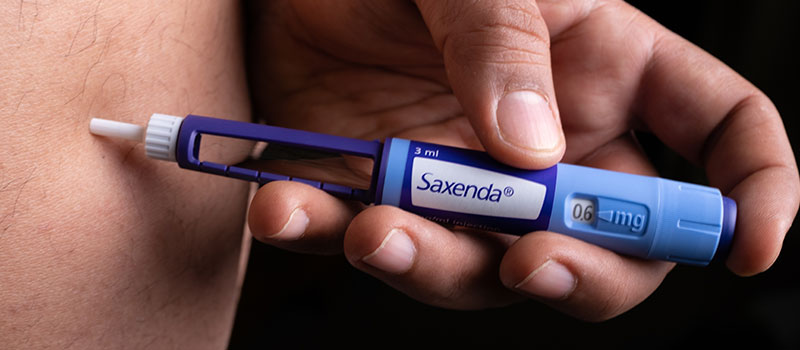Saxenda, also known by its generic name liraglutide, is an FDA-approved prescription medication used for weight management in adults with obesity or who are overweight with at least one weight-related comorbidity. It works by mimicking the effects of GLP-1, a naturally occurring hormone that regulates appetite and metabolism. Proper dosage and administration of Saxenda are essential for achieving optimal results while minimizing the risk of adverse effects. In this comprehensive guide, we’ll explore everything you need to know about Saxenda dosage and administration.

Understanding Saxenda Dosage
Saxenda is available as a pre-filled, multi-dose pen injector containing a clear and colorless solution for subcutaneous injection. The recommended dosage of Saxenda for weight management is 3.0 mg once daily, administered subcutaneously in the abdomen, thigh, or upper arm. It is important to adhere to the prescribed dosage regimen and follow the instructions provided by your healthcare provider or pharmacist.
Initiating Saxenda Therapy
Before initiating Saxenda therapy, healthcare providers should evaluate the patient’s medical history, including any pre-existing medical conditions, medications, allergies, and previous weight loss attempts. Patients with a history of pancreatitis should not use Saxenda, and caution should be exercised in patients with a history of thyroid tumors or thyroid cancer.
Titration of Saxenda Dosage
The recommended starting dosage of Saxenda is 0.6 mg once daily for one week to minimize the risk of gastrointestinal adverse effects, such as nausea, vomiting, and diarrhea. After one week, the dosage should be increased to 1.2 mg once daily. If tolerated, the dosage can be increased by 0.6 mg increments each week until the recommended maintenance dosage of 3.0 mg once daily is reached.
Administration of Saxenda
Saxenda should be administered once daily at any time of the day, with or without food. The injection site should be rotated to different areas of the abdomen, thigh, or upper arm to minimize the risk of injection site reactions. Patients should be instructed on proper injection technique, including how to prepare the injection site, insert the needle, and administer the medication.
Storage and Handling of Saxenda
Saxenda should be stored in the refrigerator at a temperature of 36°F to 46°F (2°C to 8°C) until first use. Once opened, the pen injector can be stored at room temperature (below 86°F or 30°C) or in the refrigerator. Unused pens should be discarded after 30 days, even if there is still medication remaining.
Monitoring and Follow-Up
Patients using Saxenda should be monitored regularly for weight loss progress, as well as for any adverse effects or changes in health status. Healthcare providers may adjust the dosage of Saxenda or discontinue treatment if necessary based on individual patient response and tolerability.
Potential Side Effects of Saxenda
Common side effects of Saxenda include nausea, vomiting, diarrhea, constipation, abdominal pain, headache, dizziness, fatigue, and low blood sugar (hypoglycemia). Patients should be advised to seek medical attention if they experience severe or persistent adverse effects while taking Saxenda.
If you miss a dose of Saxenda, you can take it as soon as you remember, as long as it is within the same day. However, if it is already the next day, skip the missed dose and continue with your regular dosing schedule. Do not take a double dose to make up for a missed one
No, it is important not to adjust your Saxenda dosage without consulting your healthcare provider first. Dosage adjustments should be made under the guidance of a healthcare professional based on your individual response to treatment and any potential side effects you may experience.
Yes, there are specific instructions for injecting Saxenda. Before each injection, you should clean the injection site with an alcohol swab and allow it to dry. Then, pinch a fold of skin and insert the needle at a 45 to 90-degree angle. After injecting the medication, hold the needle in place for a few seconds before removing it.
If you experience severe or persistent side effects while taking Saxenda, such as severe abdominal pain, vomiting, or signs of an allergic reaction (e.g., rash, itching, swelling), seek medical attention immediately. Your healthcare provider can assess your condition and determine the appropriate course of action.
Conclusion
Saxenda is an effective treatment option for weight management in adults with obesity or who are overweight with at least one weight-related comorbidity. Proper dosage and administration of Saxenda are crucial for achieving successful weight loss outcomes while minimizing the risk of adverse effects. By following the recommended dosage regimen and administration instructions provided by healthcare providers, patients can maximize the benefits of Saxenda therapy and improve their overall health and well-being.